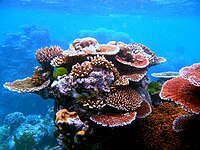
Photo from wikipedia
Residential-area segmentation is one of the most fundamental tasks in the field of remote sensing. Recently, fully supervised convolutional neural network (CNN)-based methods have shown superiority in the field of… Click to show full abstract
Residential-area segmentation is one of the most fundamental tasks in the field of remote sensing. Recently, fully supervised convolutional neural network (CNN)-based methods have shown superiority in the field of semantic segmentation. However, a serious problem for those CNN-based methods is that pixel-level annotations are expensive and laborious. In this study, a novel hierarchical weakly supervised learning (HWSL) method is proposed to realize pixel-level semantic segmentation in remote sensing images. First, a weakly supervised hierarchical saliency analysis is proposed to capture a sequence of class-specific hierarchical saliency maps by computing the gradient maps with respect to the middle layers of the CNN. Then, superpixels and low-rank matrix recovery are introduced to highlight the common salient areas and fuse class-specific saliency maps with adaptive weights. Finally, a subtraction operation between class-specific saliency maps is conducted to generate hierarchical residual saliency maps and fulfill residential-area segmentation. Comprehensive evaluations with two remote sensing data sets and comparison with seven methods validate the superiority of the proposed HWSL model.
Journal Title: IEEE Geoscience and Remote Sensing Letters
Year Published: 2020
Link to full text (if available)
Share on Social Media: Sign Up to like & get
recommendations!